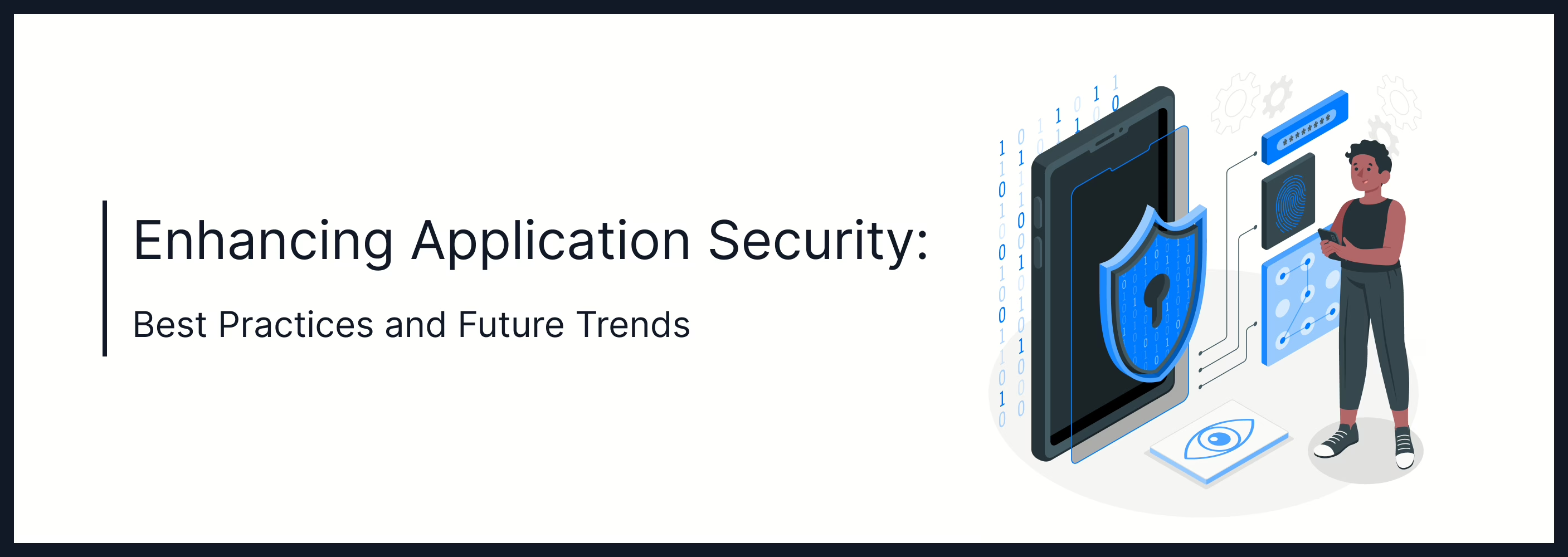
Oct 15, 2024 Information hub
Enhancing Application Security: Best Practices and Future Trends
In today’s digital age, applications are the backbone of businesses, governments, and personal interactions. From mobile apps to web-based platforms, applications are integral to our daily lives. However, as the reliance on these applications grows, so does the risk of cyber threats. This is where application security comes into play. In this blog post, we will explore the significance of application security, its relevance in today’s world, current trends, challenges, and future developments. We will also discuss practical solutions and actionable takeaways to help businesses and developers enhance their application security posture.
Introduction
In an era where digital transformation is reshaping industries, applications have become the lifeblood of modern organizations. From e-commerce platforms to financial services, applications are the primary interface through which businesses interact with their customers. However, with the increasing reliance on these applications comes a growing concern: security.
Application security refers to the measures and practices employed to protect applications from cyber threats, vulnerabilities, and unauthorized access. As cyberattacks become more sophisticated, the need for robust application security has never been more critical. In this blog, we will delve into the world of application security, exploring its importance, challenges, and the steps organizations can take to safeguard their applications.
What is Application Security?
Application security encompasses the processes, tools, and practices designed to protect applications from threats throughout their lifecycle. This includes everything from the initial design and development stages to deployment and ongoing maintenance. The goal is to ensure that applications are free from vulnerabilities that could be exploited by malicious actors.
Application security involves:
- Identifying and mitigating vulnerabilities in the code.
- Protecting sensitive data from unauthorized access.
- Ensuring that applications function as intended without exposing users to risks.
The Importance of Application Security Today
In today’s interconnected world, applications are a prime target for cybercriminals. According to a report by Verizon, 43% of data breaches in 2022 were linked to web applications. This statistic highlights the growing importance of securing applications, especially as businesses increasingly rely on cloud-based services and mobile apps.
The consequences of a security breach can be devastating:
- Financial Losses: A single breach can cost millions in fines, legal fees, and lost revenue.
- Reputation Damage: Customers lose trust in companies that fail to protect their data.
- Legal Consequences: Regulatory bodies impose strict penalties on organizations that fail to comply with data protection laws.
Given these risks, application security is no longer optional—it’s a necessity.
Common Application Security Threats
To effectively secure applications, it’s essential to understand the most common threats they face. Below are some of the most prevalent application security risks:
1. Injection Attacks
Injection attacks, such as SQL injection, occur when an attacker sends malicious code through an application’s input fields. If the application fails to properly validate the input, the attacker can execute arbitrary commands on the database, potentially gaining access to sensitive data.
Example: In 2019, a vulnerability in the British Airways website allowed attackers to inject malicious code, leading to the theft of over 400,000 customer records.
2. Cross-Site Scripting (XSS)
Cross-Site Scripting (XSS) occurs when an attacker injects malicious scripts into a web page viewed by other users. These scripts can steal session cookies, redirect users to malicious websites, or perform actions on behalf of the user without their consent.
Example: In 2020, a vulnerability in the Zoom video conferencing platform allowed attackers to execute XSS attacks, potentially compromising user accounts.
3. Broken Authentication
Broken authentication occurs when an application fails to properly manage user sessions, allowing attackers to impersonate legitimate users. This can happen due to weak password policies, session fixation, or improper token management.
Example: In 2018, a vulnerability in the Uber app’s authentication system allowed attackers to access user accounts without needing a password.
4. Security Misconfigurations
Security misconfigurations occur when an application or its infrastructure is improperly configured, leaving it vulnerable to attacks. This can include leaving default credentials in place, exposing sensitive files, or failing to apply security patches.
Example: The Equifax data breach in 2017 was caused by a failure to patch a known vulnerability in the Apache Struts framework, leading to the exposure of 147 million customer records.
Current Trends in Application Security
As the threat landscape evolves, so do the strategies and technologies used to secure applications. Here are some of the current trends shaping the future of application security:
1. DevSecOps
DevSecOps is the practice of integrating security into every stage of the software development lifecycle (SDLC). Traditionally, security was an afterthought, addressed only after the application was developed. However, with DevSecOps, security is “shifted left,” meaning it’s considered from the very beginning of the development process.
Benefits:
- Faster identification and remediation of vulnerabilities.
- Reduced costs associated with fixing security issues later in the development cycle.
- Improved collaboration between development, security, and operations teams.
2. Zero Trust Architecture
The Zero Trust model assumes that no user or device, whether inside or outside the network, should be trusted by default. Instead, every request must be authenticated, authorized, and encrypted. This approach is particularly relevant in today’s remote work environment, where employees access applications from various locations and devices.
Key Principles:
- Continuous verification of user identities.
- Least privilege access.
- Micro-segmentation of networks to limit the spread of attacks.
3. AI and Machine Learning in Security
Artificial intelligence (AI) and machine learning (ML) are increasingly being used to enhance application security. These technologies can analyze vast amounts of data to detect patterns and anomalies that may indicate a security threat.
Applications:
- Threat detection: AI can identify unusual behavior that may indicate a cyberattack.
- Automated response: Machine learning algorithms can automatically respond to certain types of attacks, reducing the time it takes to mitigate threats.
Challenges in Application Security
Despite advancements in security technologies, organizations still face several challenges when it comes to securing their applications:
1. Rapid Development Cycles
With the rise of agile development methodologies and continuous integration/continuous deployment (CI/CD) pipelines, applications are being developed and released at a faster pace than ever before. While this accelerates innovation, it also increases the risk of security vulnerabilities being introduced into the code.
2. Lack of Security Awareness
Many developers lack formal training in secure coding practices, leading to the introduction of vulnerabilities during the development process. Additionally, non-technical stakeholders may not fully understand the importance of application security, leading to a lack of investment in security measures.
3. Evolving Threat Landscape
Cyber threats are constantly evolving, with attackers developing new techniques to exploit vulnerabilities. This makes it challenging for organizations to stay ahead of the curve and ensure their applications are protected against the latest threats.
Best Practices for Enhancing Application Security
To mitigate the risks associated with application security, organizations should adopt the following best practices:
1. Secure Coding Practices
Developers should be trained in secure coding practices to prevent common vulnerabilities such as SQL injection and XSS. This includes:
- Validating and sanitizing user input.
- Using parameterized queries to prevent SQL injection.
- Avoiding hardcoding sensitive information such as passwords or API keys.
2. Regular Security Testing
Security testing should be an integral part of the development process. This includes:
- Static Application Security Testing (SAST): Analyzing the source code for vulnerabilities.
- Dynamic Application Security Testing (DAST): Testing the application in a running state to identify vulnerabilities.
- Penetration Testing: Simulating real-world attacks to identify potential weaknesses.
3. Implementing Multi-Factor Authentication (MFA)
MFA adds an extra layer of security by requiring users to provide two or more forms of authentication before accessing an application. This significantly reduces the risk of unauthorized access, even if a user’s password is compromised.
4. Encryption and Data Protection
Sensitive data, both at rest and in transit, should be encrypted to prevent unauthorized access. This includes using HTTPS for web applications and encrypting sensitive information stored in databases.
Case Studies: Real-World Application Security Breaches
1. Equifax Data Breach
In 2017, Equifax, one of the largest credit reporting agencies, suffered a massive data breach that exposed the personal information of 147 million people. The breach was caused by a failure to patch a known vulnerability in the Apache Struts framework. This incident highlights the importance of timely patch management and security updates.
2. SolarWinds Cyberattack
In 2020, the SolarWinds cyberattack compromised several U.S. government agencies and private companies. Attackers inserted malicious code into a software update for SolarWinds’ Orion platform, which was then distributed to thousands of customers. This attack underscores the importance of securing the software supply chain and monitoring for suspicious activity.
Future of Application Security
As technology continues to evolve, so too will the field of application security. Some key developments to watch for in the coming years include:
- Increased use of AI and automation: AI will play a larger role in threat detection and response, helping organizations stay ahead of emerging threats.
- Greater emphasis on privacy: With the introduction of regulations such as the General Data Protection Regulation (GDPR) and the California Consumer Privacy Act (CCPA), organizations will need to prioritize data privacy and security.
- Quantum computing: While still in its early stages, quantum computing has the potential to break traditional encryption methods. Organizations will need to explore quantum-resistant encryption techniques to protect their applications.
Conclusion
In an increasingly digital world, application security is more important than ever. As cyber threats continue to evolve, organizations must take proactive steps to secure their applications and protect sensitive data. By adopting secure coding practices, implementing regular security testing, and staying informed about the latest trends and challenges, businesses can significantly reduce their risk of a security breach.
Actionable Takeaways:
- Integrate security into every stage of the development process (DevSecOps).
- Regularly test your applications for vulnerabilities using SAST, DAST, and penetration testing.
- Implement multi-factor authentication to enhance user security.
- Stay informed about the latest security trends and emerging threats.
By prioritizing application security, organizations can safeguard their digital assets and maintain the trust of their customers in an increasingly interconnected world.
